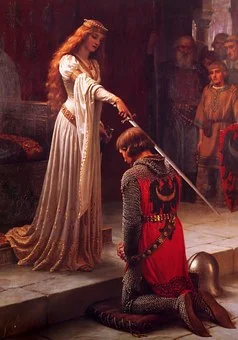As the Dark Ages faded into the feudal world of the Middle Ages, a new form of popular music developed. The songs told stories about knights and ladies, forbidden love and battles. These pop tunes were known as chansons d’amour (songs of love) and chansons de geste (songs of war).
Songs of love resembled modern “historical romances” (aka bodice-rippers) with heart-broken lovers and cuckolded spouses. Songs of war created an idealized image of knights and often ended in a heroic death, like Song of Roland.
For those who missed the treat of reading Song of Roland in a literature class, Charlemagne sent Roland and his buddy, Oliver, to fight the Saracens (Muslims in Spain) who were trying to advance into France. Roland was a blithering idiot who should never have been given command of anything and Oliver nagged him all the way to the Pyrenees to be careful. Many verses later, it ends with Oliver saying “I told you so” and everyone heroically dying as they save France and Christendom. (Now you don’t have to waste time reading the original.)
These songs were performed by troubadours and minstrels who were the rock stars of their day. Like modern rock stars, they went on summer tours, traveling from town to town to perform at festivals for saints, summer fairs and town market days. If they were lucky, a local baron would hire them for the winter to provide entertainment at the baron’s court.
Troubadours and minstrels were musicians and usually played several instruments, including lutes, an early version of an acoustic guitar. They performed a standard repertoire of popular tunes. They were also songwriters creating fresh material to entertain their audiences, including the local baron who hired them for the winter and expected to be repaid with a dedicated song.
Chansons originated in France and are often associated with the Dukes of Aquitaine. Duke Guillaume IX wrote poetry and chansons. His granddaughter, Eleanor of Aquitaine, lived a life straight out of the chansons. She married pious King Louis VII of France and accompanied him on the Second Crusade, scandalizing the Church and the military. She later became bored in Paris and divorced Louis so she could marry Henry of Anjou, soon to be Henry II of England.
Years later after one of her frequent fights with Henry II, she grabbed her young son Richard (the Lion-Hearted) and moved to Poitier to set up her own court. Her eldest French daughter, Marie, joined her at her new Court of Love. They commissioned chansons, poems, and a medieval version of Emily Post’s manners for knights and ladies. Their code of courtly conduct set the social standard for generations of aristocrats and noblemen.
Chansons live on today in fragmentary pieces and in book-length poems, like Song of Roland. They provide the plot for countless operas of infidelity and forbidden love. Sir Thomas Malory collected chansons d’amour and chansons de geste which he then incorporated into his book, La Morte D’Arthur, published in 1485. Malory’s Arthurian tales became the ultimate blockbuster franchise retold in many forms, including the musical Camelot and Disney’s animated feature, The Sword in the Stone.
To recapture the flavor of those traveling singers, visit a Renaissance fair or listen to the street musicians that clog up sidewalks in every city. Chansons are discussed in Eleanor of Aquitaine and the Four Kings, by Amy Kelly (1978) and A Distant Mirror: The Calamitous 14th Century, by Barbara W. Tuchman (1978).
Want to receive this blog straight to your inbox? Sign up for my mailing list.




